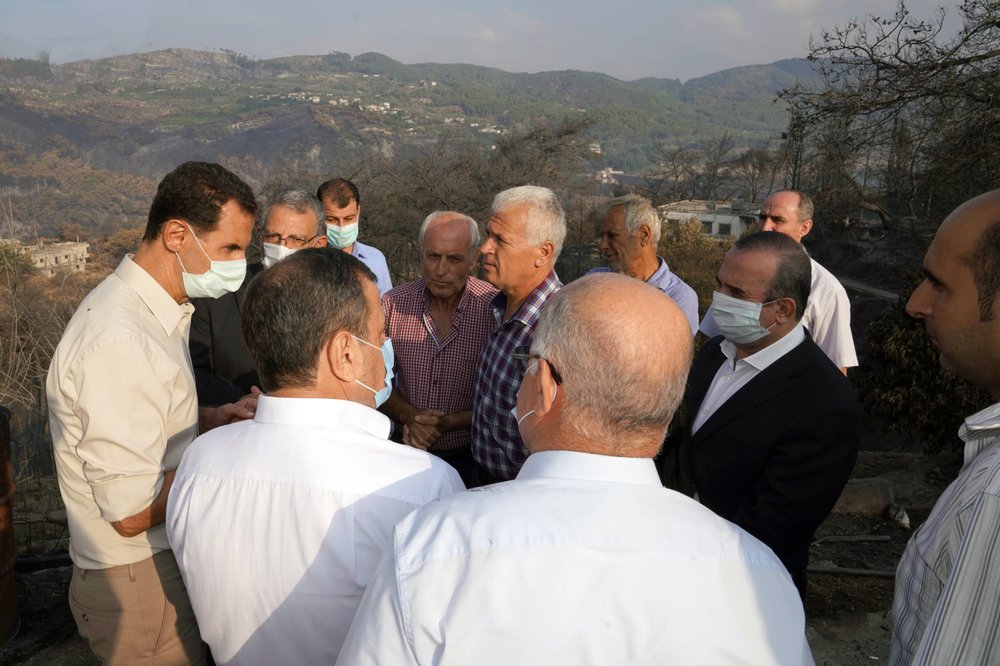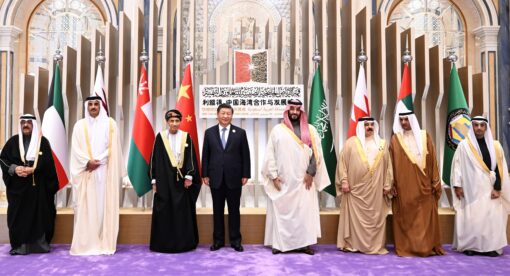Wildfires spread across western Syria in September and October, devastating large swaths of the countryside. The U.N. Office for the Coordination of Humanitarian Affairs reported that 156 fires had occurred across the provinces of Homs, Tartus, and Latakia, all of which are home to sizable Alawite communities. While the fires only resulted in three fatalities, the preliminary report claimed that 70 were injured and up to 25,000 were displaced, and 9,000 hectares of agricultural land were destroyed, impacting the livelihoods of as many as 140,000 people. Though Syrian President Bashar al-Assad rushed to mollify the Alawite community with pledges and photo ops, these fires represent the latest in a cascade of “loyalist” grievances to which his regime appears unable to coherently respond.
Deceptive Optics and False Promises

In the aftermath of the crisis, Syrian President Bashar al-Assad toured a number of villages impacted by the fires in a public relations maneuver designed to showcase his commitment to his Alawite base. This began in rural Latakia, where Assad, accompanied by Latakia’s governor and the Syrian minister of agriculture, pledged to financially compensate the victims, insisting that “the state would shoulder the biggest responsibility for this support.” The visit to the predominantly Christian town of Mashta al-Helou, located in Tartus’ mountainside, was also highly publicized. In contrast, the Sunni-populated municipality of al-Haffeh in rural Latakia, which suffered considerable damage, was shunned, likely due to its confessional makeup and rebellious past.
By prioritizing areas populated by religious minorities, Assad intended to reinforce his persona as the guarantor of minority security, particularly for the Alawites. Pictures and videos uploaded onto official social media accounts depict Assad and the first lady, Asma, meeting with crowds of affected villagers. However, the videos are injected with music to drown out distraught voices then unmuted at key junctures in which the president is heard offering motivational advice and when pro-Assad chants are shouted.
Though the choreographed optics are intended to placate the community, pictures of Assad meeting with the distressed and offering shallow assurances are unlikely to offset the sight of cataclysmic flames devouring their homes.
In a video shared on Twitter, an Alawite man films a fire surrounding his home. He sarcastically thanks the state for enabling its spread “because it’s irrelevant if we live or die.” In another video, a group of Alawites is seen criticizing government officials for their indifference, including a minister, whom they claim arrived for a photo op then subsequently drove off to avoid answering questions. The demographic’s small size and geographic concentration guarantees that word of such transgressions spreads quickly.
The author’s Alawite sources on the coast echo these frustrations and claim they are widespread. They angrily questioned why neither the state nor its Iranian and Russian allies had assisted, especially given the proximity of the latter’s airbase at Khmeimim to the coastal mountains.
Layers of Resentment
On Oct. 9, state media’s Alikhbaria broadcast a video depicting a handful of Syrian soldiers struggling to put out small fires. Owing to severe water shortages, the troops were forced to use tree branches in lieu of hoses or buckets of water. The video was later shared on Twitter, where it elicited a mixture of mockery and condemnation from opponents of the regime. However, Alawite overrepresentation in the military means that these visuals denote a sense of loss and despair to the community.
The armed forces make up a key pillar of Alawite identity and have for nearly a century constituted their main institutional vehicle for attaining upward social mobility and prestige. The community’s loss of more than one third of their men of military age fighting for the regime against an overwhelmingly Sunni armed opposition has further entrenched this interdependence. It also transmuted the Syrian coast into a perpetual cycle of funerals, to which the ubiquitous posters commemorating fallen soldiers serve as a constant reminder. As such, any scenario that exposes these troops to danger risks reigniting a communal narrative of sacrifice, centered around their youth once again being forcibly deployed to the front lines without support.
Conversations within the community center on the divide between the elites and the impoverished Alawites who are commonly linked to the discourse of sacrifice. Economic implosion and the decimation of the Syrian pound have effectively thrust a formerly comfortable middle class into poverty. Whereas Alawites are disproportionately represented in the public sector, the average state salary – a meager 50,000 SYP ($21) per month – means that the vast majority live well below the poverty line, as the average family, according to a Syrian newspaper, requires 700,000 SYP ($304) per month in order to live comfortably.

This highlights the regime’s failure to reward Alawite loyalty with dignified living standards. Rising food insecurity forces hungry Syrians to purchase expired vegetables at a reduced price. Queues at gas stations due to fuel shortages extend for kilometers. In October alone, the price of gasoline increased twice, while the cost of diesel – used for residential heat and cooking, in addition to operating bakeries and fueling Syria’s cheapest mode of transportation, microbuses – more than doubled. Basic necessities have become virtually unaffordable.
Given all this, defusing growing Alawite anger will require the regime to devise a strategy that goes beyond temporary scapegoats and immaterial platitudes.
Policy Paralysis
Many of the communities impacted by the fires are subsistence farmers that depend on the profits accrued from harvesting crops such as olives, citrus, and tobacco. They commonly require a mixture of short- and long-term loans from the state’s Agricultural Cooperative Bank. Yet systemic corruption, mismanagement, and a collapsed economy have depleted state coffers, making it unlikely that the regime will compensate those whose homes and livelihoods have been destroyed.
Assad has attempted to raise money through the Ministry of Internal Trade and Federation of the Syrian Chambers of Commerce. According to the pro-regime newspaper Al-Watan, the ministry announced Oct. 12 that it raised a sum of 400 million SYP ($163,000) in the first hour of its campaign. If true, this still falls substantially short of addressing the scope of destruction caused by the fires. The minister of agriculture also said he was working with the Farmer’s Union to formulate a plan to compensate coastal families, but he qualified this by stressing the persistence of “major problems related to [the] securing of agriculture production requirements as a result of unilateral coercive measures imposed on Syria,” namely “sanctions and terrorism.” This is a clear regime attempt to evade liability for failing to secure funds.
Assad has also looked to various “charitable” agencies. This includes the first lady’s own supposed NGO, the Syria Trust for Development, which claims to have secured 8 billion SYP (about $2.8 million) through a private fund launched to raise and organize donations from all “financially-abled Syrians.” The NGO recently stated that it has begun compensating affected villagers. However, in an interview with pro-regime radio station Sham FM, a resident of Alawite al-Fakhoura asserts the funds are being distributed by local officials in a nepotistic fashion. This example illustrates that, in the improbable case that Assad secures the necessary finances, his regime cannot prevent its clientelist networks from capturing them. The regime’s diffusion of power since 2011 has led to unprecedented corruption amid the rise of relatively autonomous war profiteers, from militias to businessmen, that act as intermediaries on which it is now dependent.
Independent Alawite Mobilization: Past Precedents

Outside of individual members hailing from a class of intellectuals, artists, and political dissidents, few Alawites actively joined the uprising in 2011. Those who did generally partook in cross-confessional protests that stressed national unity.
Yet there are several notable precedents for separate Alawite mobilization independent of other communities. In October 2014, protests erupted in Homs after twin suicide bombings killed 47 schoolchildren in the Alawite-majority district of Akrama. The incident elicited calls for the governor’s resignation as many deplored the regime’s indifference.
That same month, rising fuel prices triggered Alawite demonstrations in Tartus. Their galvanization was partly fueled by the execution and disappearance of hundreds of soldiers that summer when Islamic State forces overran the Tabqa Military Airport in Raqqah. The regime’s attempt to downplay the situation provoked stark rebukes from the community and prompted online campaigns demanding the whereabouts of the missing soldiers. Activists distributed leaflets angrily addressing the president. “The throne is for you,” they read, “and the coffin is for our sons.”
In August 2015, the president’s cousin, Suleiman al-Assad, shot and killed a decorated Syrian Air Force colonel in Latakia City in a bout of road rage. According to the colonel’s brother, Suleiman had disparaged the Syrian military before killing the officer. Protests calling for Suleiman’s execution ensued in the Alawite neighborhood of Al-Zira’a. The debasing of the army – viewed as the only buffer between Alawites and a vengeful, sectarian opposition – by a privileged member of the ruling class struck a political nerve.
Alawite youth – the current backbone of the army – are inundated with a sense of hopelessness as the prospect of discharge from compulsory military service and forced conscription, once a dream to many, seems remote or unpromising, not simply because the regime reneges on its commitments but also because employment opportunities are unavailable elsewhere. The spread of parasitic pro-regime militias operating with impunity and their disregard for breadlines, gas queues, and ration restrictions, in addition to their harassment of people desperately awaiting their turn, has contributed to an atmosphere in which fights break out. In Latakia and Hama, these fights have reportedly resulted in a few deaths.
While triggered by specific events, these past eruptions were more than simply reactive. Their reflexiveness, though momentary and producing demonstrations that were small in overall numbers, represented socio-political effusions resulting from years of afflicting circumstances.
Explaining Alawite Dormancy

So far, the regime has been able to maintain the veneer of deniability and evasion in the eyes of its loyalists. Its time-tested tactic of externalizing blame and deflecting responsibility is currently being sustained by several exogenous factors. These include the presence of Turkish and American troops on Syrian soil and their support for rival armed actors, the sporadic persistence of Israeli strikes, and the implementation of U.S. sanctions through the Caesar Act, which collectively breathe life into the regime’s otherwise exhausted rhetoric.
Additionally, the community’s disproportionate representation in the security apparatus relative to its Sunni counterparts complicates efforts to mobilize. People considering organizing widespread civil disobedience are deterred by the specter of pre-emptive detention by the dreaded mukhabarat. The regime’s periodic security reshuffling further blurs the ability to identify potentially dangerous agents within their own community, magnifying the perceived threat posed by the omnipresence of informants.
Apart from fear of arrest and torture, accusations of disloyalty and treason carry with them a stigma that risks severe ostracization. The regime’s hypernationalized propaganda links its existence to that of the state. Thus, proponents of the government can claim that dissenters are benefiting the “enemies of the homeland.”
Potential Scenarios and Implications of Alawite Unrest
Broadly speaking, three scenarios underpin the prospect of an Alawite eruption. First, the regime’s inability to check its repressive impulses could lead to a situation in which Alawites related to members of the officer corps are arrested and tortured – or worse, disappeared – for public critiques of the government, causing backlash from its own coercive forces. Second, the regime could begin arresting soldiers and officers themselves for similar reasons, with the same outcome. Third, the deterioration of living standards could ultimately lead to a breaking point.
In the scenario that a spontaneous eruption does occur, the decisive factor will rest on the military, a fractured institution with at best questionable capability. Nine years of conflict have eroded the structures that have been central to the regime’s methodic coup-proofing practices. Any organized dissent would require the support of its rank-and-file soldiers, most of whom share similar, if not identical, grievances with the wider community, and could thus be sympathetic. This could potentially cause a schism within the Alawite community as familial allegiances are weighed against loyalty to the Assad dynasty and its regime, particularly if ordered to repress protests in Alawite areas.
For better or for worse, the Alawites are holding Assad’s rump state together. Any abrupt breakdown of the current system risks destabilizing regime-held territories and effectively transforming them from a failed state to one that has arguably collapsed altogether – a reality that neither Washington nor Moscow would deem acceptable.
The only conceivable scenario in which Assad’s departure can occur at the hands of the Alawites while salvaging the state and avoiding further regional instability would be through a palace coup led by disgruntled officers and backed by Russia. However, the likelihood that Russia could simply replace or abandon Assad, its growing frustrations notwithstanding, is low, not least due to lack of an alternative. Though the Kremlin’s long game in the Middle East requires a stable and reliable client in Damascus – one that at a minimum can meaningfully consolidate authority over its territories – Russia’s grip on the armed forces should not be overstated. Iranian entrenchment, both within the formal institutions of the regime and the state’s security landscape more broadly, continues to exploit Assad’s tenuous authority in order to obstruct Russian attempts to monopolize patronage.
Iran is a force for regime continuity. By creating a parallel network of control that bypasses the state, Iran has thus far been able to reproduce its influence, particularly through its ongoing relations with a patchwork of non-state militias, while resisting Russian efforts at vertically integrating these actors into the formal structures of a centralized Syrian state. Moreover, it works closely with Maher al-Assad, Bashar’s brother and commander of the 4th Armored Division, the most powerful and coup-proofed mobilization in the Syrian military. It therefore has a vested interest not just in the regime but also in ensuring that Assad remains president.
Alawite Defection: Remote Possibility or Inevitable Reality?
Throughout the conflict, the regime has actively exploited Alawite fears of annihilation to circumvent opposition from within the community. Beginning in 2011 with its release of imprisoned extremists, a move intended to derail the uprising, the regime played the leading role in engineering facts on the ground critical to corroborating the false binary at the heart of its survival: Either accept the stability and security of the state – however perilous – or test the genocidal dispositions of the “jihadist” opposition. This manufactured self-fulfilling prophecy alienated and entrapped the Alawites as the conflict protracted, the army and its affiliated militias committed sectarian atrocities, and the armed opposition gradually radicalized. The capture of Jisr al-Shughour in Idlib, located at the doorstep of the Alawite heartland, by an alliance of Islamist rebels in the spring of 2015 signaled to the community that they were now unequivocally stuck with the regime. Their solidarity intuitively peaked around this understanding.
In the aftermath of the September-October wildfires, a number of loyalist accounts on social media attributed responsibility to the governor of Latakia and demanded he step down. However, they failed to assign accountability either to the regime at large or the president. Similarly, in 2019, just weeks after Rami Makhlouf was targeted by the regime as part of Assad’s “anti-corruption” campaign, a music video to the tune of the Italian protest song Bella Ciao circulated on pro-regime pages depicting the country as run by a “gang of thieves.” In addition to Makhlouf, it blamed elements of Syria’s nouveaux riches, such as Samer Foz and the Katerji brothers, for being responsible for their economic woes, but asked that the president intervene to rescue them. This idea – that the president is innocent despite being surrounded by villains – is not uncommon among the Alawites.
Today’s context is drastically different. Apart from the Turkish-backed factions in the north, the threat of Sunni reprisals occupies less of an immediate concern to most Alawites than their ability to secure food, shelter, and transportation amid a shattered economy and unstable currency. Additionally, the looming threat of COVID-19 may ultimately lead them to conclude that the prospect of starvation and disease at the hands of the regime is at least as likely as the specter of slaughter by the rebels, causing a reassessment of their existential calculus. The status quo is unsustainable – irrespective of the sect’s fears of a resurgent Sunni opposition.
Nizar Mohamad is a Toronto-based independent Middle East analyst who specializes in Syrian politics and security. Mohamad has previously worked on Canada’s Syrian refugee project. He Tweets at @NizarMohamad1.
The views expressed in this article are those of the author and not an official policy or position of the Newlines Institute.







